Learn how to make Canadian Poutine at home (perfect for New Year’s)! This poutine recipe is the ultimate guide for everything you need to know about poutine from what cheese to use, how to make poutine gravy and the best homemade French fries!
Poutine is a simple yet indulgent Canadian dish made of crispy French fries and chunks of salty, softened cheese curds smothered in a tangy gravy. This holy trinity of ingredients merges to create something truly magical as the hot fries with their golden crisp exteriors and pillowy interiors and the robust, steaming hot gravy gently melt the cheese curds so they soften but still maintain their signature squeaky shape. Poutine can be made 100% from scratch or is fabulous to use with leftover gravy. I’ve also included how to make poutine recipe with baked French fries, how to prep ahead, how to store and how to freeze.
Potatoes are one of my favorite foods in the world! If you’re also a potato fan, be sure to check out: Company Mashed Potatoes, Smashed Potatoes, Twice Baked Potatoes, Au Gratin Potatoes, Carne Asada Fries and Roasted Pesto Potatoes.

PIN THIS RECIPE TO SAVE FOR LATER
Why you will love these Canadian Fries with Gravy
I wanted to bring you the best poutine recipe in time for New Year’s because it’s a scrumptious, fun snack and party food! I’ve researched and experimented until I’ve come up with the best possible Canadian poutine to share with you. A perfect poutine recipe is the sum of the best of its three parts, which somehow become exponentially more delicious together:
- The fries: Made with thick-cut, Russet potatoes that are soaked and double fried to create a tender, creamy interior and golden crispy exterior. Frying your French fries twice might sound like a lot of work, but is easy and essential. The first fry at a lower temperature cooks and softens the potatoes and the second fry at a higher temperature creates the coveted golden, crispy crunch.
- The gravy: A multi-dimension beef gravy lightened up with chicken broth and punched up with splashes of vinegar, ketchup, Worcestershire sauce and hand-picked seasonings. The gravy is flavorful and laced with just enough tangy sass as to not overwhelm the fries and cheese curds. It’s also thick enough to pool and hang on the fries and not slide right off.
- The cheese: Chunks of room temperature cheese curds allow them to soften under the heat of the steamy gravy.
What Is Poutine?
Poutine is a Canadian dish consisting of French fries and cheese curds, all slathered in gravy. It was created in the 1950’s and it’s most strongly associated with Quebec. The recipe I’m sharing today is a Canadian poutine, but you can make it all sorts of non-traditional and top it with anything you’d like. Some restaurants use cheese sauce in place of gravy, sometimes shredded meat. bacon, mushrooms is added, and more.
Honestly, any form of poutine sounds good to me! What doesn’t pair well with fried potatoes and gravy?!
How To Pronounce Poutine
It largely depends on what region you are in or from. Most English-speaking Canadians will pronounce poutine how it looks in American English, “poo-teen.” If you find yourself in Quebec which is largely comprised of French Canadians, and what to pass for a real Québécois, it’s pronounced “poo-tin.”
Where Did Poutine Originate
Poutine is agreed to have originated in Quebec in the 1950s, but several restaurants claim the honor. One story claims a truck driver was served hot French Fries and cheese curds at a restaurant called Le Lutin Qui Rit in Warwick, Quebec in 1957, at his request for something “hot to go.”
Since that time, poutine has been widely popularized across Canada and can be found everywhere from fine dining menus to fast-food chains including McDonald’s and Burger King. It has become the quintessential Canadian dish!
Why is it Called Poutine?
“Poutine” is from a Québécois slang word meaning “mess.” Legend has it that when a customer requested cheese curds with the fries, the restaurant owner exclaimed, “Ça va faire une maudite poutine” or “that will make a d**n mess.”
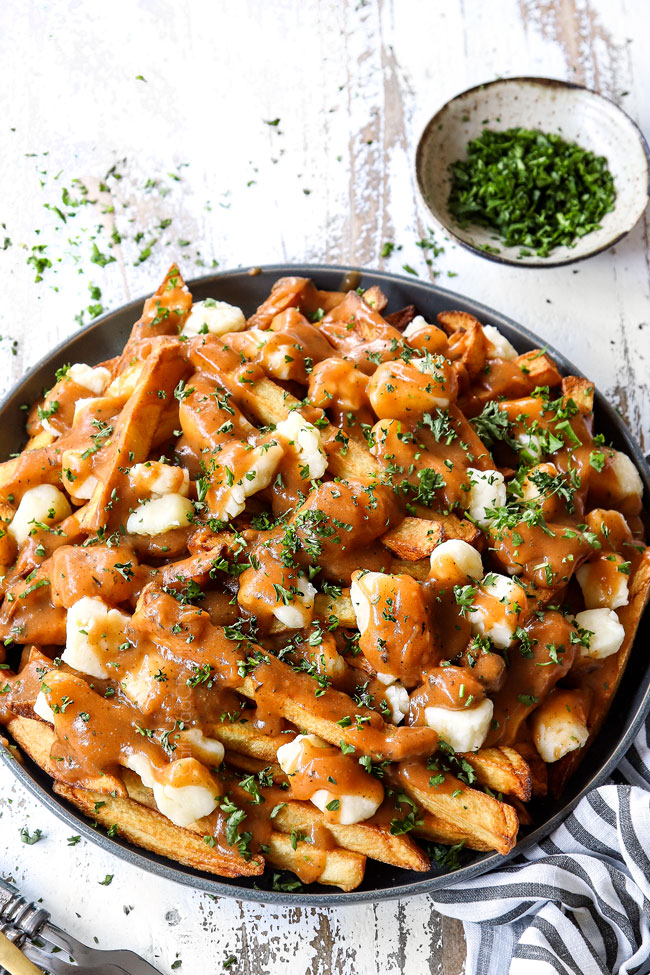
Poutine Fries with Gravy ingredients
This poutine recipe requires surprisingly few ingredients. Here’s what you’ll need:
- Butter: Use unsalted butter so you can control the amount of salt in the gravy.
- All-purpose flour: Equal parts flour and butter are combined to create a roux. This is what makes the gravy so thick and creamy!
- Beef broth: Use reduced sodium beef broth to prevent an overly salty gravy.
- Chicken broth: Is often used in combination with beef broth to lighten the gravy and give it more dimension. If you would like a “beefier” gravy, feel free to use all beef broth. Alternatively, if you would like a lighter gravy, swap some of the beef broth for chicken broth.
- Beef bouillon: intensifies the flavor of the gravy. You can use granulated beef bouillon, bouillon cubes or better than bouillon. If using cubes, you will need one cube that you smash before adding to the gravy – don’t dissolve it in water first.
- Cornstarch: Thickens up the gravy. Whisk it in thoroughly so there are no clumps!
- Ketchup, cider vinegar and Worcestershire sauce: add a tangy dimension to the gravy characteristic of Canadian poutine. Add more or less to taste.
- Spices: The poutine gravy is flavored with a mixture of onion powder, garlic powder, dried parsley, paprika, oregano, and thyme.
What potatoes are best for Poutine Fries?
Russet potatoes are the best potatoes for making poutine because they are denser and have the least amount of moisture which = crispier fries. Russet potatoes may also be labeled as Idaho or baking potatoes. If you have the option, choose Burbank Russets because they develop a crisper texture and cook more evenly than Norkotah Russets, the other widely available variety.
Your potatoes need to be rinsed before using but it is up to you whether or not you want to peel them. I prefer to peel the potatoes but you can leave the skins on for a more rustic poutine recipe.
What oil is best for Canadian Poutine?
Refined peanut oil is a type of vegetable oil and is the best oil for making French fries. You can also use regular vegetable oil, canola or safflower oil. Do NOT use olive oil or any oil with a low smoking point or strong flavor. If you select an oil with a low smoking point, not only will you have an incredible amount of smoke, but the oil will break down creating an unpleasant odor and unappetizing taste.
Can I reuse my frying oil?
Yes! Reusing your oil will actually produce crispier French fries. The general rule of thumb is that you can reuse frying oil three or four times. After using, strain the oil and store it in an airtight container in either the refrigerator or a cool, dark, dry place. Before using, make sure the oil is still good by checking for any separation and giving it a whiff – if smells off, don’t use it.
What cheese to use for this Poutine Recipe?
Poutine is not poutine without the cheese curds, otherwise known as “squeaky cheese.” Cheese curds are pillowy little peanut-sized lumps of fresh, young cheese that have a mild flavor like mozzarella. They are perfect for poutine because the cheese maintains its shape, but becomes warm and melts slightly when blanketed in the hot gravy.
What are Cheese Curds?
Cheese curds are the result of the cream separating from the water whey in the formation of milk. The cream solidifies and becomes cheese curds OR is pressed into molds and aged to form blocks of cheese. Because cheese curds haven’t been pressed into a mold, they contain more air which causes them to “squeak” when bitten into (the fresher the curds, the squeakier). This squeaky cheese might sound odd, but taste delicious!
Where to buy cheese curds for poutine
Cheese curds should be located in or near the deli section of your grocery store along with the other high-quality cheeses. I have had luck finding them at my grocery store as well as Sprouts and Whole Foods. Cheese curds can be found in white cheddar or yellow cheddar but you’ll want white for traditional Canadian poutine.
Substitute for Cheese Curds in Poutine
If you can’t locate cheese curds, use a block of low moisture mozzarella cheese, torn or chopped into large chunks, 1-2 inches. You don’t want to use fresh mozzarella because it will be too watery and you don’t want to use shredded mozzarella because it melts into the hot gravy. Instead, the cheese is supposed to remain soft and distinct.

How to make Poutine Fries
This poutine recipe isn’t too tricky. Honestly, the hardest part is patience while deep frying the French fries in batches! And if you’ve never fried before, you’ll get the hang of it quickly!
How Do You Make Poutine Gravy?
I’ve detailed the poutine gravy ingredients and cooking method below but first I wanted to talk gravy. Poutine gravy runs the gamut of flavors from distinctly chicken gravy to distinctly beef gravy and everywhere in between. In this recipe, I’ve loosely followed French-Canadian chef Ricardo recipe that uses 2/3 beef stock and ⅓ chicken stock to create a lighter beef gravy. Of course, you are welcome to use more chicken broth or more beef broth. In the end, it comes down to personal preference.
Step 1: Make the Poutine Gravy
- Whisk the cornstarch with the chicken broth. Make sure it’s fully dissolved then whisk again before adding later.
- Make a roux by cooking flour in melted butter for a full two minutes. The roux will start off clumpy then become a smooth paste. Don’t shortcut this process – you don’t want to be able to smell any raw flour after it’s cooked.
- Add the rest of the Gravy ingredients: beef broth, chicken broth, ketchup, apple cider vinegar, Worcestershire sauce and seasonings.
- Simmer the gravy until thickened. The gravy will thicken more as it stands. Don’t worry about it getting cold – you’ll warm it again before drizzling over the French fries.
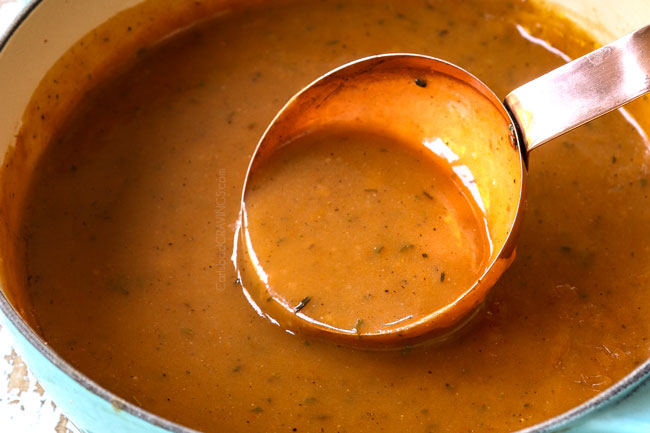
Step 2: Make the French Fries
- Slice the potatoes into ½-inch thick fries. I like to measure one fry then use it as a guide for the rest.
- Soak the potatoes in a large bowl of cold water in the refrigerator for a minimum of two hours, preferably overnight. The longer you soak the potatoes, the crispier the French fries.

- Rinse fries by transferring potatoes to a strainer and rinse thoroughly with cold water for several minutes. Scoop up a handful of fries, rinse again, pat dry and transfer to paper towels or a clean dishcloth. Dab them again so they’re as dry as possible. Repeat with all of the fries.
- Fry the potatoes for the first fry at 325 degrees F by transferring a small batch of potatoes to the oil and frying for about 4-6 minutes or until very lightly golden, stirring occasionally. We are cooking the potatoes so they’re soft, not frying to crisp up yet. Transfer fries to paper towels and repeat with remaining fries, about 6 batches.
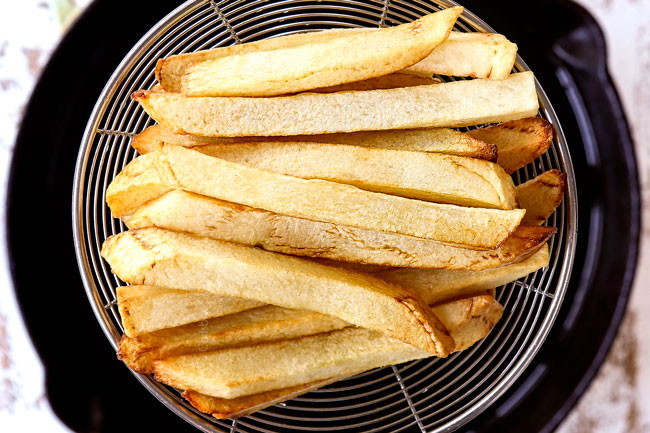
- Fry the potatoes for the second fry at 425 degrees F in batches until they are crisp and golden-brown, about 3-4 minutes.
- Sprinkle fries with salt immediately after transferring to paper towels to drain.

Step 3: Assemble the Poutine
- Divide French fries between serving plates or add to one large platter.
- Top with cheese curds followed by hot gravy. Make sure the curds are slathered in gravy so they soften. Serve immediately.

How to bake French Fries for Poutine
- Soak, drain and dry potatoes per recipe instructions.
- Preheat oven to 400 degrees F. Line a large baking sheet with foil.
- Toss potatoes with ¼ cup melted butter and ¼ cup neutral oil such as canola or vegetable oil. Toss with salt.
- Line the fries in a single layer on the baking sheet so they aren’t touching. Bake at 400 degrees F in the lower-third of the oven for 25 minutes.
- Remove from the oven, stir potatoes and rearrange back into a single layer. Bake for 10-15 more minutes or until brown and crispy.
How to use store-bought French fries
Although many might consider store-bought French fries blasphemy, sometimes you just need the quick and easy route. You can use any store-bought frozen French fries and bake them according to package directions. Make sure your gravy is ready when the fries come out of the oven so you can quickly assemble the poutine while they’re hot.
How to Eat Poutine
Poutine is not like digging into naked French Fries or even messy nachos, you will need and want a fork! Poutine can be served individually and eaten with a fork or family style where everyone dives into one large platter of poutine (the latter is not suggested during this crazy time!).
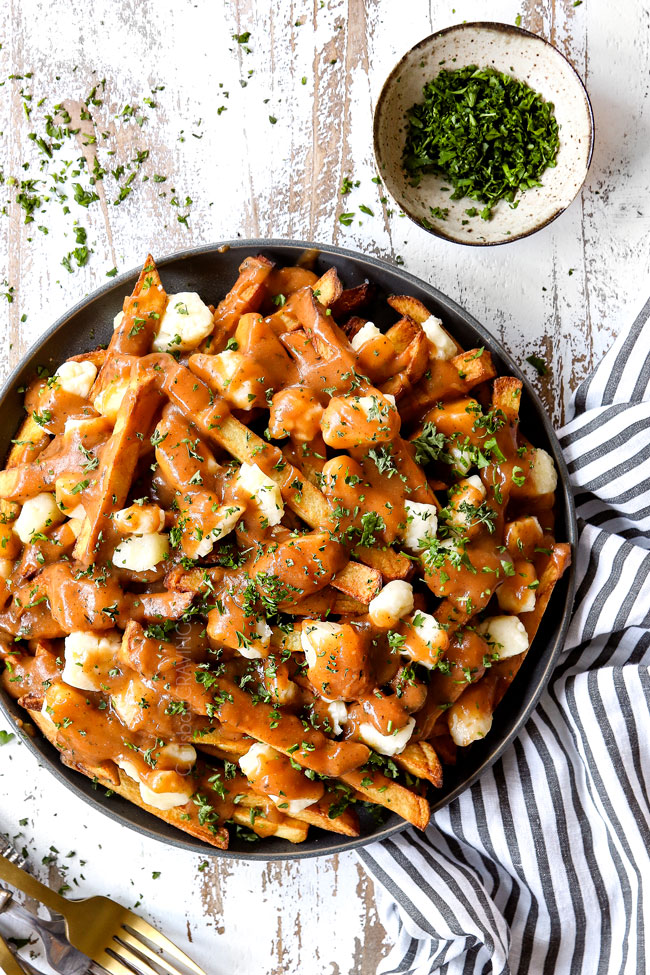
Tips for Making Canadian Poutine
- Use Russet potatoes. Don’t be tempted to use any other variety of potatoes, especially waxy potatoes such as Yukon gold. Waxy potatoes are filled with so much water that evaporates when fried, leaving you a hollow, collapsing potato!
- Uniform large fries. Make sure to cut your fries into similar sizes so that they cook at the same rate. Cut them ½-inch and not any smaller so they can stand up to the rich gravy, otherwise they’ll quickly become droopy and fall apart.
- Transfer fries to water immediately. Potatoes oxidize, meaning they turn brown when exposed to the air/oxygen, so you’ll want to transfer them to the bowl of cold water as you cut them, as opposed to adding water to the fries once they’re all cut.
- The longer you soak the potatoes in water, the better. Soaking the potatoes removes the starch which makes for extra crispy fries.
- Thoroughly rinse potatoes. After you soak the fries, rinse them under cold water until the water turns clear. This means you have rinsed off any excess starch.
- Thoroughly dry the potatoes. Be sure to thoroughly dry your potatoes after rinsing because any residual water can react with the hot oil and cause it to spatter.
- Use a thermometer! There isn’t an accurate way to check and adjust your oil temperature without using a thermometer. A candy or frying thermometer are handy because they clip onto the edge of the pot to ensure it doesn’t slide around and allows you to continuously read the temperature. If you don’t have one of these thermometers, an instant read thermometer will also work, you’ll just have to be more diligent checking the temperature yourself.
- Use a large deep pot. The French fries are deep fried, which means we need 3-inches deep of oil. To accommodate this much oil without worrying about splattering, you’ll need a pot that’s at least 6-inches deep. I LOVE my deep frying pan and highly recommend it, even if you only fry a couple times a year. If you don’t have a deep-frying pan, the best pots for deep frying are cast iron pots (specifically enameled cast iron like a Dutch oven) and metal pots.
- Fry in batches. There are a lot of fries, so you might be tempted to cram more fries into a batch at once – but don’t! You’ll need to fry the French fries in about six batches. Frying too many fries at once makes them less crispy. It can also make the oil bubble over – dangerous!
- Monitor the French fries. The first batch of French fries generally will require more time and the last batch typically requires less time, so be flexible and watch those fries! You’ll also want to monitor the temperature of the oil and adjust the heat as necessary.
- Cool fries after the first fry before frying a second time. This step isn’t essential but it will create crispier fries. As the fries cool, moisture in the center of the potatoes migrates to the surface of the fries, which is why the surface gets soggy again. Frying the potatoes for a second time boils off that moisture. If you don’t let the potatoes rest, the trapped moisture stays in the center of the fries even after the second fry, creating softer fries. Note: For the crispiest fries, instead of just cooling the fries after the second fry, freeze them by spreading them out on a baking sheet, then frying from frozen.
- You must double fry the potatoes. In order to ensure the fries are fully cooked on the inside before the outsides crisp up, the fries need to be cooked twice. If you don’t fry them twice, you’ll end up with undercooked, brown French fries, or soft, greasy, limp French fries. The Double-Fry Method produces perfectly tender insides and crispy outsides every time.
- Use room temperature cheese curds. Cold cheese curds won’t soften even when drenched with hot gravy. Instead, room temperature curds are the only way to go. Remove the cheese curds from the refrigerator when you start heating your oil.
- Make thick gravy. You want the gravy on the thicker side so it clings to the French fries and cheese curds and doesn’t just slip. For thicker gravy, simply simmer longer.
- Adjust to taste. After the gravy is finished, taste and add more vinegar if you would like a tangier gravy.
- Warm the gravy. After the fries are finished, the gravy will thicken and cool. Simply reheat the gravy, adding additional broth as needed before drizzling on the poutine. The gravy, needs to be hot enough to soften the curds, but not so hot that it melts them completely or burns your tongue!
- Serve immediately. Poutine is best served immediately because the fries soften as they sit and the gravy will cool and thicken.
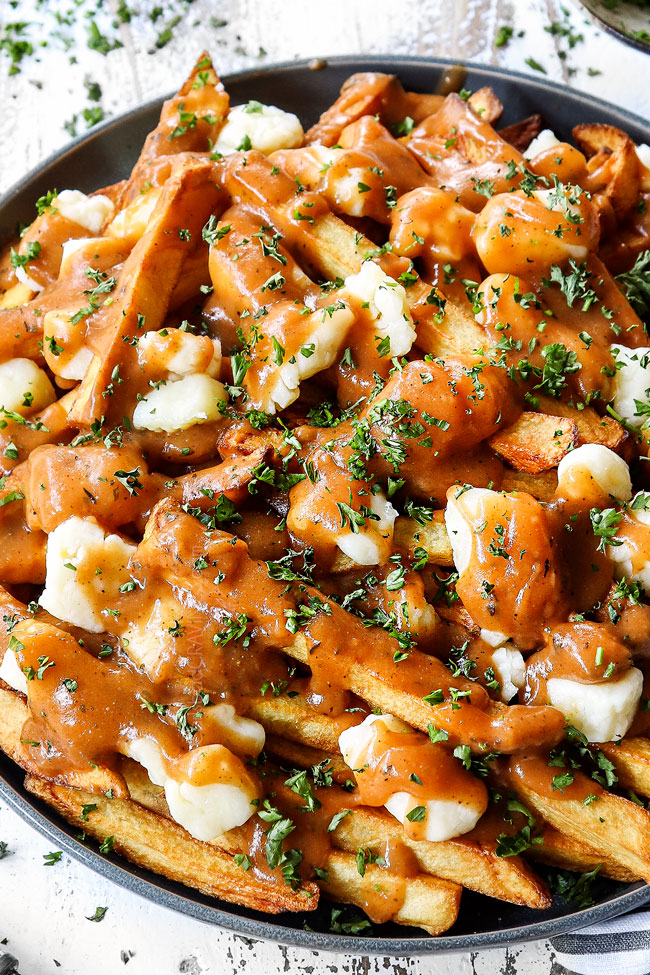
Canadian Poutine Recipe variations
If you can dream it, you can make poutine out of it! Obviously, classic Canadian poutine is French fries with gravy but I’ve seen Canadian restaurants with all sorts of non-traditional “poutine” combos such as Italian poutine, veggie poutine, Irish poutine, cheesy lobster poutine, Jerk chicken poutine and even butter chicken poutine! Essentially, you can make poutine with any sauce and toppings – just don’t call it authentic 😉. Here are just a few ideas to get your creative juices flowing:
- Season French fries. Try seasoning the freshly fried French fries with Cajun seasoning, garlic seasoning, chipotle seasoning, Italian seasoning, etc.
- Use sweet potatoes. I love classic poutine with Russet potatoes, but I’ve seen recipes for sweet potato poutine and I’m so intrigued! Note that sweet potato fries may require different cook times than Russet potatoes. They also will not be nearly as crispy.
- Serve with baked potatoes. My brother mentioned when they’re feeling extra lazy, they skip the fries altogether and serve the poutine gravy over baked potatoes – yum!
- Serve with tater tots. Another lazy day alternative would be to swap the French fries for crispy tater tots!
- Seasoned cheese cruds. Some grocery stores (or definitely online)offer different flavored cheese curds such as roasted garlic or jalapeno.
- Add meat. To make this poutine a full meal, try adding bacon, ground beef, marinated steak, Italian beef, balsamic beef, beef barbacoa, sweet pulled pork, etc.
- Top with leftover meat and gravy. Leftover gravy makes fabulous poutine, and while you’re at it, add some leftover beef to make it a complete meal. Try topping French fries with crockpot beef tips and gravy, baked chuck roast and gravy, crockpot chuck roast and gravy or Mississippi roast and gravy.
- Make breakfast poutine. Cook breakfast sausage until browned, then add the flour directly to the sausage and continue to make the gravy. Add a soft-boiled egg, avocado, and/or bacon to complete the meal.
- Make Italian poutine. It might sound odd, but Italian poutine is a popular variation served at restaurants and uses marinara sauce instead of gravy. You can also use Bolognese, Italian meatballs with Marinara or even Chicken Parm!
- Unconventional “gravy.” Top the French fries with anything! Try chili cheese dip, chicken Florentine, beef stew, honey buffalo meatballs with sauce, crockpot sloppy Joes, crockpot chili, chili mac, barbecue brisket, Swedish meatballs, or any of my curries: red curry, yellow curry, green curry, or coconut curry.
- Make cheeseburger poutine. Not really “poutine” but a fun idea. Top French fries with cheese sauce, crumbled hamburger and desired topping such as pickles, jalapenos, bacon, etc.
- Make it veggie. Make a simple mushroom gravy or add additional veggies to the gravy.
Can I prep Canadian Fries in advance
Once assembled, this Canadian poutine is best eaten immediately. However, you can prep components of this recipe in advance:
- Gravy: Can be made up to 48 hours in advance and reheated gently on the stove just before serving. Be aware that the chilled gravy will be very thick but will thin over heat. If it’s still too thick for your liking, simply stir in a little broth or water until it reaches desired consistency.
- Soak fries: Fries can be sliced and left to soak in water up to overnight.
- Freeze fries: To partially make French fries, complete the 1st round of frying several hours in advance, freeze the fries by spreading them out on a baking sheet. Fry the potatoes from frozen for the 2nd fry right before serving. Frying the fries from frozen will create even crispier fries – winning!
- If you would like to make the fries 100% in advance: Store them in an airtight container then reheat in the oven or air fryer. Note, that reheated French fries in the oven won’t be as crispy and fries reheated in the air fryer will take several batches.
What to serve with Poutine Fries
Canadian poutine is a hearty meal in and of itself so I prefer serving it with simple, lighter sides. A few of my favorites include:
- Classic Fruit Salad
- Cucumber Tomato Salad
- Green Bean Salad
- Spinach Berry Salad
- Wedge Salad
- Tropical Fruit Salad
How to store Fries with Gravy
Poutine is best eaten right away because the leftover French fries become soft unless reheated in the air fryer. That being said, the flavor is still excellent.
- Storage: Leftover Canadian poutine can be stored in the fridge for up to three days, noting that the fries will become soggy over time.
- Air fryer: Is the best way to reheat poutine. I used the air fryer “snack” setting for 6 minutes. You will want to transfer the poutine to foil before adding to the air fryer so it’s easy to remove and so the gravy doesn’t get everywhere.
- Oven: Transfer poutine to a foil lined pan or baking dish and baked at 300 degrees F until warmed through, about 15 minutes.
- Microwave: Reheating this poutine recipe in the microwave would be my last choice because the fries get softer. Transfer poutine to a microwave safe dish and reheat for 60 seconds then at 15 second intervals as needed.
Can You Freeze Poutine?
Once assembled, you shouldn’t freeze poutine. However, you can fry the potatoes and freeze them for later. Likewise, you can also make and freeze the gravy separately.
- To freeze French fries: Lay the cooked French fries on a parchment paper-lined baking sheet and place in the freezer for about an hour, or until hardened (this is called “flash freezing” so they don’t stick together). Next, transfer fries to a freezer bag, squeeze out excess air and freeze for up to 3 months.
- To warm partially cooked French fries: It is best to freeze French fries after the first fry then “rewarm” them by completing with the second fry at 425 degrees F from frozen. This will produce the best/crispiest fries.
- To warm fully cooked French fries: When ready to eat, spread frozen fries into an even layer on a baking sheet and heat in a 350 degrees F oven until warm (about 15 to 20 minutes).
- To freeze gravy: Let cool completely, then seal inside a freezer bag or freezer-safe container for up to 3 months. When ready to eat, thaw overnight and reheat in a saucepan over low heat.
More like this Poutine Recipe
- Carne Asada Fries
- Baked Parmesan Fingerling Fries
- Baked Mexican Fries
- Garlic Butter Smashed Potatoes
- Scalloped Potatoes au Gratin
- Crockpot Mashed Potatoes
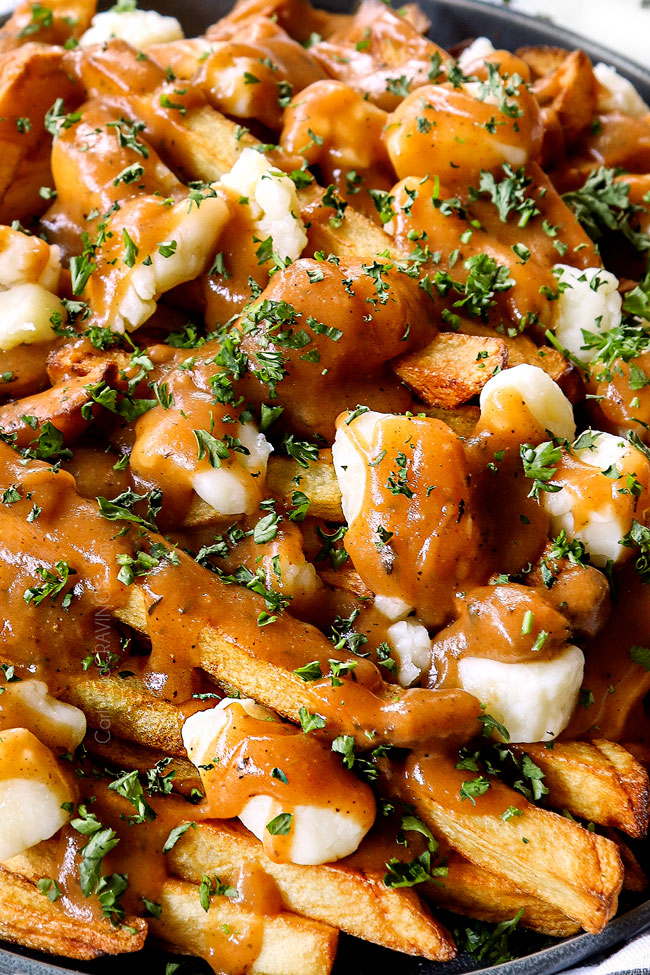
Want to try this Poutine RECIPE?
Pin it to your Dinner, Snack, Appetizer or Party Board to SAVE for later!
Find me on Pinterest for more great recipes! I am always pinning :)!
©Carlsbad Cravings by CarlsbadCravings.com
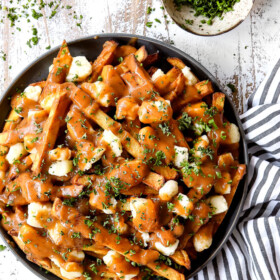
Poutine Fries with Gravy
Save This Recipe To Your Recipe Box
You can now create an account on our site and save your favorite recipes all in one place!
Ingredients
GRAVY
- 1 cup low sodium chicken broth
- 1 1/2 tablespoons cornstarch
- 2 1/2 cups low sodium beef broth
- 4 tablespoons unsalted butter
- 1/4 cup flour
- 1 tablespoon ketchup
- 1 tablespoon apple cider vinegar
- 1/2 teaspoon Worcestershire sauce
- 1 tsp EACH dried parsley, granulated beef bouillon
- 1/2 tsp EACH paprika, garlic powder, onion powder, salt, pepper
- 1/4 tsp EACH dried oregano, dried thyme
FRENCH FRIES & CHEESE
- 4 lbs. russet potatoes peeled, washed
- Vegetable oil for frying
- table salt
- 2 cups white cheddar cheese curds at room temperature
Instructions
PREP FRENCH FRIES
- Slice the potatoes into 1/2-inch thick fries. I like to measure one fry then use it as a guide for the rest. Transfer potatoes to a large bowl of cold water as you cut them. Soak the potatoes in refrigerator for a minimum of 2 hours, preferably overnight. The longer you soak the potatoes, the crispier the French fries.
- Transfer potatoes to a strainer and rinse thoroughly with cold water. Scoop up a handful of fries, rinse again, pat dry and transfer to paper towels or a clean dishcloth. Dab them again so they’re as dry as possible. Repeat with all of the fries.
MAKE GRAVY
- Whisk cornstarch with chicken broth until no lumps remain; set aside.
- Melt butter in a medium saucepan over medium heat. Add flour, and cook while stirring for 2 minutes (no less!). Turn heat to low and gradually whisks in beef broth followed by chicken broth (with cornstarch). Add all remaining gravy ingredients and bring to a boil. Reduce to a simmer until thickened (gravy will thicken more upon standing).
- Remove from heat and season with salt and pepper to taste – I like ¼ teaspoon EACH more of both. Taste and add more vinegar if you would like a tangier gravy. Set aside.
COOK FRENCH FRIES
- Add enough oil to 6 qt (or larger) fry pan or Dutch oven until it reaches 3 inches up the sides (or use a deep fryer). Heat oil to 325 degrees F. Line your adjoining counter or a large baking sheet with a double layer of paper towels (to place potatoes once fried).
- Using a spider strainer or slotted spoon, transfer a small batch of potatoes to the oil and fry for about 4-6 minutes or until lightly golden, stirring occasionally. We are cooking the potatoes so they’re soft (you should be able to cut them with the side of the spoon), not frying to crisp up yet. Transfer fries to paper towels and repeat with remaining fries, about 6 batches.
- Optional for crispier French fries: Turn off stove and let fries cool for 20 minutes or freeze until ready for the second fry.
- Increase the oil temperature to 425 degrees F. Fry the potatoes in batches for a second time until they are crisp and golden-brown, about 3-4 minutes. Transfer French fries back to paper towels and immediately sprinkle and toss with a generous amount of salt.
ASSEMBLE
- Reheat the gravy until it is hot (so it will soften the cheese curds). Add a splash of broth if it has become too thick.
- Divide French fries between serving plates. Top with cheese curds followed by hot gravy. Make sure the curds are slathered in gravy so they soften. Serve immediately.
Notes
Tips for Making Canadian Poutine
- Beef bouillon: You can use granulated beef bouillon, bouillon cubes or better than bouillon. If using cubes, you will need one cube that you smash before adding to the gravy – don’t dissolve it in water first.
- Use correct oil: Refined peanut oil is a type of vegetable oil and is the best oil for making French fries. You can also use regular vegetable oil, canola or safflower oil. Do NOT use olive oil or any oil with a low smoking point or strong flavor.
- Cheese curds: You should be able to find them in or near the deli section of your grocery store along with the other high-quality cheeses. If you can’t locate cheese curds, use a block of low moisture mozzarella cheese, torn or chopped into large chunks, 1-2 inches.
- Russet potatoes: Don’t be tempted to use any other variety of potatoes, especially waxy potatoes such as Yukon gold. Waxy potatoes are filled with so much water that evaporates when fried, leaving you a hollow, collapsing potato!
- Uniform large fries: Make sure to cut your fries into similar sizes so that they cook at the same rate. Cut them ½-inch and not any smaller so they can stand up to the rich gravy, otherwise they’ll quickly become droopy and fall apart.
- Thoroughly dry the potatoes: Any residual water can react with the hot oil and cause it to spatter.
- Use a thermometer! There isn’t an accurate way to check and adjust your oil temperature without using a thermometer. A candy or frying thermometer are handy because they clip onto the edge of the pot to ensure it doesn’t slide around and allows you to continuously read the temperature. If you don’t have one of these thermometers, an instant read thermometer will also work, you’ll just have to be more diligent checking the temperature yourself.
- Fry in batches: There are a lot of fries, so you might be tempted to cram more fries into a batch at once – but don’t! You’ll need to fry the French fries in about six batches. Frying too many fries at once makes them less crispy. It can also make the oil bubble over – dangerous!
- Monitor the French fries: The first batch of French fries generally will require more time and the last batch typically requires less time, so be flexible and watch those fries! You’ll also want to monitor the temperature of the oil and adjust the heat as necessary.
- Cool fries after the first fry before frying a second time: This step isn’t essential but it will create crispier fries. As the fries cool, moisture in the center of the potatoes migrates to the surface of the fries, which is why the surface gets soggy again. Frying the potatoes for a second time boils off that moisture. If you don’t let the potatoes rest, the trapped moisture stays in the center of the fries even after the second fry, creating softer fries. Note: For the crispiest fries, instead of just cooling the fries after the second fry, freeze them by spreading them out on a baking sheet, then frying from frozen.
- You must double fry the potatoes: In order to ensure the fries are fully cooked on the inside before the outsides crisp up, the fries need to be cooked twice. If you don’t fry them twice, you’ll end up with undercooked, brown French fries, or soft, greasy, limp French fries. The Double-Fry Method produces perfectly tender insides and crispy outsides every time.
- Use room temperature cheese curds: Cold cheese curds won’t soften even when drenched with hot gravy. Instead, room temperature curds are the only way to go. Remove the cheese curds from the refrigerator when you start heating your oil.
- Recipe variations. See the post for TONS of fun recipe ideas.
How to bake French Fries for Poutine
Baked French fries won’t be as crispy, but still tasty! You can also bake store-bought frozen French fries in a time crunch.- Soak, drain and dry potatoes per recipe instructions.
- Preheat oven to 400 degrees F. Line a large baking sheet with foil.
- Toss potatoes with ¼ cup melted butter and ¼ cup neutral oil such as canola or vegetable oil. Toss with salt.
- Line the fries in a single layer on the baking sheet so they aren’t touching. Bake at 400 degrees F in the lower-third of the oven for 25 minutes.
- Remove from the oven, stir potatoes and rearrange back into a single layer. Bake for 10-15 more minutes or until brown and crispy.
How to Prep Ahead
Once assembled, this Canadian poutine is best eaten immediately. However, you can prep components of this recipe in advance:- Gravy: Can be made up to 48 hours in advance and reheated gently on the stove just before serving. Be aware that the chilled gravy will be very thick but will thin over heat. If it’s still too thick for your liking, simply stir in a little broth or water until it reaches desired consistency.
- Soak fries: Fries can be sliced and left to soak in water up to overnight.
- Freeze fries: To partially make French fries, complete the 1st round of frying several hours in advance, freeze the fries by spreading them out on a baking sheet. Fry the potatoes from frozen for the 2nd fry right before serving. Frying the fries from frozen will create even crispier fries – winning!
- If you would like to make the fries 100% in advance: Store them in an airtight container then reheat in the oven or air fryer. Note, that reheated French fries in the oven won’t be as crispy and fries reheated in the air fryer will take several batches.
How to Store and Reheat
Poutine is best eaten right away because the leftover French fries become soft unless reheated in the air fryer. That being said, the flavor is still excellent.- Storage: Leftover Canadian poutine can be stored in the fridge for up to three days, noting that the fries will become soggy over time.
- Air fryer: Is the best way to reheat poutine. I used the air fryer “snack” setting for 6 minutes. You will want to transfer the poutine to foil before adding to the air fryer so it’s easy to remove and so the gravy doesn’t get everywhere.
- Oven: Transfer poutine to a foil lined pan or baking dish and baked at 300 degrees F until warmed through, about 15 minutes.
- Microwave: Reheating this poutine recipe in the microwave would be my last choice because the fries get softer. Transfer poutine to a microwave safe dish and reheat for 60 seconds then at 15 second intervals as needed.
How to Freeze
Once assembled, you shouldn’t freeze poutine. However, you can fry the potatoes and freeze them for later. Likewise, you can also make and freeze the gravy separately.- To freeze French fries: Lay the cooked French fries on a parchment paper-lined baking sheet and place in the freezer for about an hour, or until hardened (this is called “flash freezing” so they don’t stick together). Next, transfer fries to a freezer bag, squeeze out excess air and freeze for up to 3 months.
- To reheat partially cooked French fries: It is best to freeze French fries after the first fry then “rewarm” them by completing with the second fry at 425 degrees F from frozen. This will produce the best/crispiest fries.
- To reheat fully cooked French fries: When ready to eat, spread frozen fries into an even layer on a baking sheet and bake at 350 degrees F until warm (about 15 to 20 minutes).
- To freeze gravy: Let cool completely, then seal inside a freezer bag or freezer-safe container for up to 3 months. When ready to eat, thaw overnight and reheat in a saucepan over low heat.

Did You Make This Recipe?
Tag @CarlsbadCravings and Use #CarlsbadCravngs
Leave a Review, I Always Love Hearing From You!
Carlsbad Cravings© Original

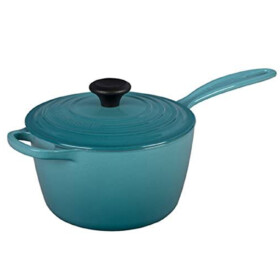
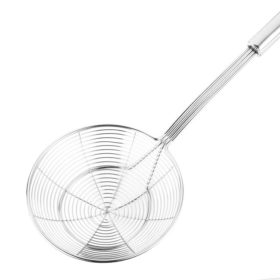
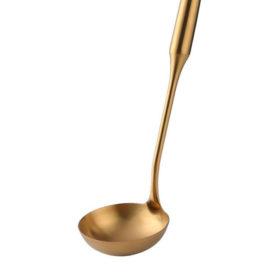

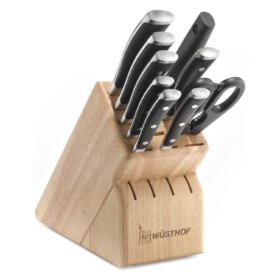
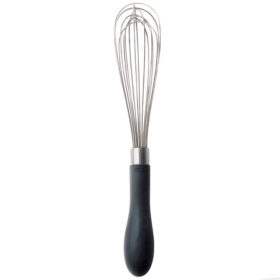

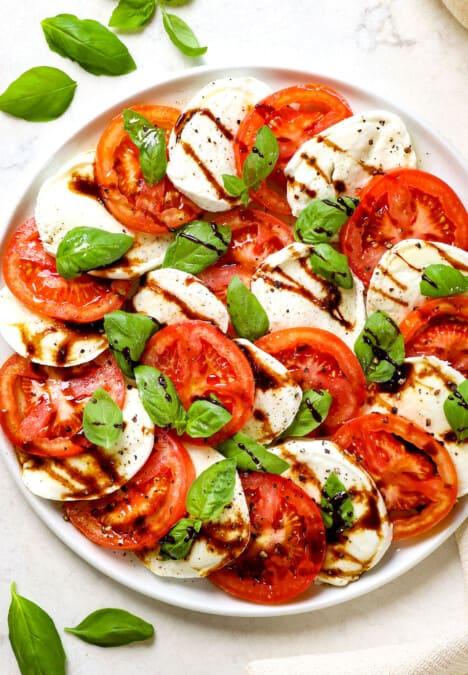
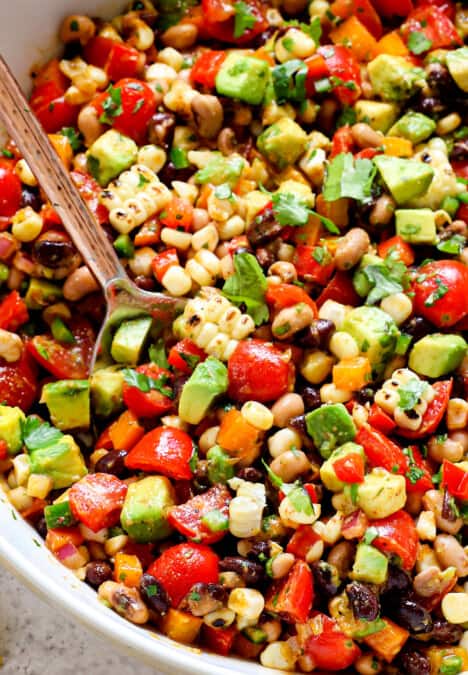
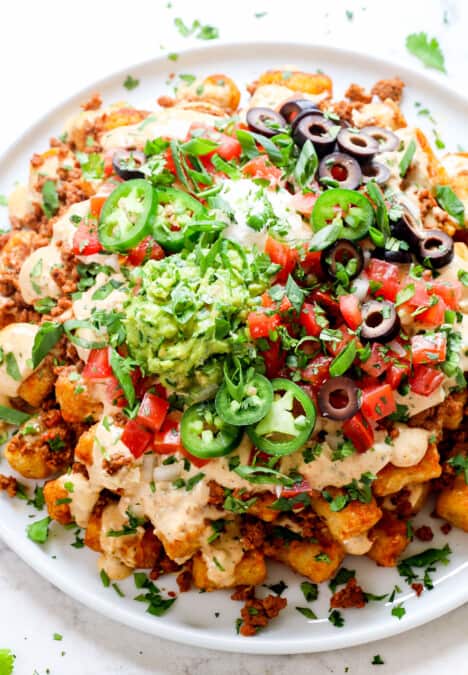

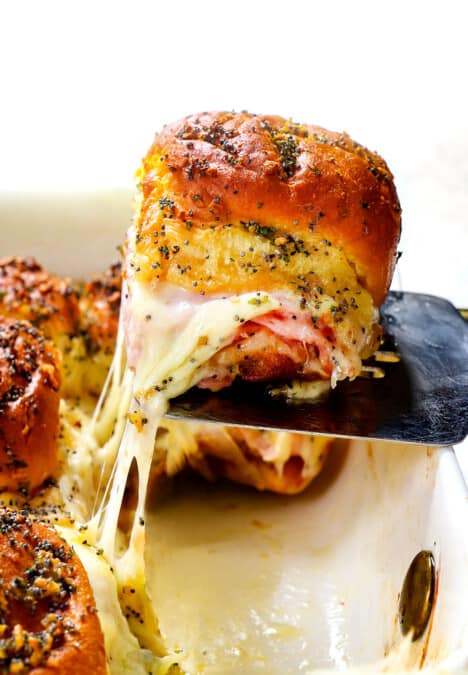























Charmaine says
Will definitely be trying this recipe soon. Wondering what brand of beef and chicken stock you use ? I haven’t found one that really tastes good. Thanks
Jen says
Hi Charmaine, I use Swanson’s Chicken Bone Broth and for beef broth: Colavita, Swansons or Bonafide Provisions. If you find your broth is lacking, you can always amp it up with granulated chicken bouillon or beef bouillon – works wonders!
Bex says
Could you please clarify how much parsley is added in the gravy, the ingredients say 1tsp with the granulated bouillon and the next line says 1/2 tsp? I’ve winged it and added 1tsp as I can’t see it making a whole lot of difference. Can’t wait to eat this all together.
Jen says
I’m so sorry about that! It should be 1 tsp – fixed! Hope you love it!
Laura says
Hi Jen,
As a resident of Canada who loves your website and recipes, I was delighted to see poutine on the menu.
I encourage all of your readers to try and make this at home. It might seem labour intensive, but it is delicious. I like my fries extra crispy and light on the gravy so the fries don’t get soggy.
Mozzarella is definitely an acceptable substitute for cheese curds if they are not available. And, fresh cheese curds are the best (they are kind of squeaky when you eat them) but mozzarella is also good,
Jen says
Hi Laura, I’m embarrassed I’m just now responding to your comment! I got swamped over the holidays and am still playing catchup but I SO appreciate you taking the time to comment – especially because you are an authority on the subject! I’m honored you are following my blog from Canada and appreciate your tips! I know many readers might shy away because they can’t find cheese curds, so I appreciate your mozzarella endorsement. I hope I did our poutine justice!
Sahar says
OMG Jen!
I think you can read my mind/my CRAVINGS!! I absolutely LOVE LOVE LOVE poutine! The nearest place in my area (the only one where poutine was available) closed down and your recipe, like all the others, is a God-send!
I love the tips you’ve given to make the homemade fries so crispy.. And the gravy, I dip my vegetables in the left overs, thickened it up and used it in sandwiches too
Your recipes bring such joy.. Can’t thank you enough 🙂
Happy New Year!
Jen says
LOL! We are foodie kindred spirits! I’m so glad this recipe came at just the right time and I’m drooling over the thought of adding gravy to sandwiches. Happy Healthy New Year to you as well! xo
Wren says
I made this this evening and it was an absolute hit with my family! The gravy is especially delicious! Thank you for the wonderful instructions!
Jen says
You’re so welcome Wren! I’m so pleased your whole family loved it, thank you!
April says
Delicious!
I am far too lazy to make my own fries, so I used frozen seasoned waffle fries. And cheese curds aren’t that easy to find so I used a mix of shredded cheddar and mozz. It all worked great even if it make the recipe less Canadian. 😉 I grew up just south of Montreal in upstate NY and I love poutine.
I’ll probably make a few tweaks next time. I’m thinking about substituting tomato paste for the ketchup and maybe even experimenting with red wine vinegar rather than apple cider vinegar. I can’t wait to make it again! No more regular brown gravy mix for us! I’d halved the recipe for the two of us.
Jen says
Sorry for the late reply— I’m catching up on a backlog of comments, but I’m so happy that you made it your own! I hope it continues to be a repeat!